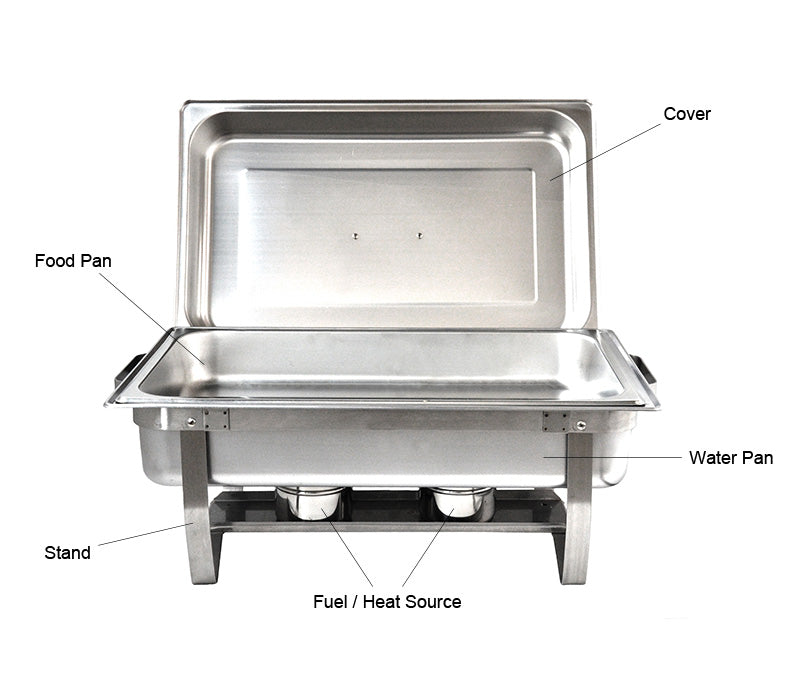Experts ready to help
Experts ready to help

Serving a cold or even room temperature meal is a major foodservice faux pas guaranteed to scare away customers and guests to any establishment. However, with a chafing dish it’s easy to keep your freshly cooked dishes hot, like they just came out of the oven.
Also called chafers, buffet servers, or even warmers, this essential piece of equipment is frequently used by caterers, buffet-style restaurants, and hotels for keeping cooked food hot during service. You’ll find them in hotel breakfast bars, banquet halls, and at catered events like weddings.
The word chafer originates from the French word, chauffer, meaning “to heat.” A chafer is essentially a large serving vessel with a heat source and lid. They’re designed to keep any type of food or dish hot for hours after they’ve been cooked, ensuring that even the last person in the buffet line receives a hot meal. They’re used to hold anything from pancakes, steak, and potatoes to soups, sauces, and everything in between.

Chafing dishes feature four main parts: a food pan, water pan, lid, and a type of fuel or heat source.
The food pan is made out of a food and oven safe material like stainless steel or ceramic. Since chafers aren’t designed to cook food, it’s common to place the entire food pan in the oven and then move it to the chafer when it’s ready, where it’ll be kept hot for serving.
A water pan sits underneath the food pan and above the fuel source. When the water in the pan gets hot, it produces steam that heats the food while preventing it from burning or drying out.
Chafers are also equipped with a lid that helps retain heat and keep food hot. They come in a variety of styles from lift-off to roll-top to suit the different needs of each venue.
Finally, in order for a chafing dish to adequately keep food hot for an extended time, it needs a heat source. Depending on whether it’s a fuel, electric, or induction chafer, it may also be equipped with a stand to hold it directly above the heat source while in use.
Fuel
Electric
Induction
There are three main types of chafing dishes, categorized by their heating style. They can be heated by either fuel, electric, or induction sources and while it ultimately depends on preference, some options may be better suited to certain environments than others.
Fuel: Fuel chafers use small cans of chafing fuel to heat the water dish and keep food hot. These fuel cans contain either a flammable gel or a liquid with an ignitable wick. Both are safe to burn inside and are convenient to use at outdoor venues since they don’t require an electrical outlet. Gel fuels are excellent at delivering hot holding temperatures, while wicked fuel cans are known to be safer since the liquid isn’t combustible in itself. You can find chafing fuel that will burn for as little as two hours and up to six hours. Some are also equipped with screw-top lids that allow you to seal and re-use them as needed.
Electric: Electric chafers are a convenient option for keeping food hot when there’s easy access to an electrical outlet. Since there are no open flames, they’re safer than fuel chafers and are also an excellent option for outdoor use when wind has the potential to put out flames. However, it is important to consider what extension cords may be needed as well as where they’re placed in order to prevent guests and staff from tripping over them.
Induction: Similar to electric, induction chafers require access to an outlet as well as an induction plate or induction cooker. These types of chafing dishes are more commonly found indoors on induction buffet tables and venues featuring fixed or drop-in induction cooktops. Induction chafers are a popular choice since it provides the most even heat distribution that prevents hot and cold spots. They’re also well known for being extremely safe to use.
The heating source isn’t the only characteristic you need to consider when purchasing a chafer. These handy devices also come in a range of shapes and sizes. Some allow for more versatility in what dishes they serve, while others may only be able to serve specific dishes like soups and other hot liquids.
The size of chafer you choose will depend on the size of your buffet table and how much food you’re going keep inside. Chafers come in full, half, and 2/3 sizes. Full-size chafers have an 8-9 quart capacity or larger and usually come in a rectangular shape. Half-size chafers hold 4-5 quarts and are usually square or rectangular in shape. Round chafers come in many sizes but typically fall in the 2/3-size range or right in-between the full and half size capacities. They’re typically able to hold between 4 and 7 quarts, with the deeper soup or marmite chafers falling on the larger side.
The final consideration when selecting a chafing dish for your business is the type of lid or cover it’ll have. In order to choose the right one, you need to consider your guests and whether they’ll be serving themselves or being served by staff.
It’s important to consider the type of atmosphere your restaurant or business offers when selecting a particular style of chafing dish. Is it for a cozy and casual breakfast buffet or for a classy wedding reception dinner? Your environment will dictate the style of chafer you’ll display. From the most basic, user-friendly designs to more ornate and classic styles, there’s a chafing dish for every occasion and every setting.